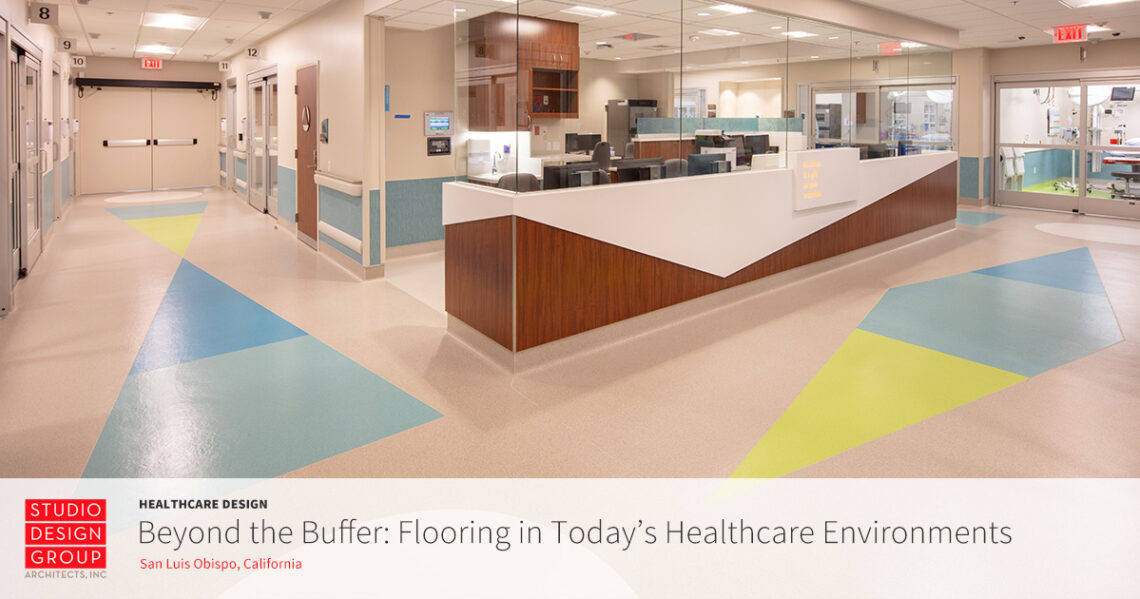
There was a time when hospitals and other healthcare environments were known for their very boring, very shiny waxed floors. Today, our San Luis Obispo healthcare design team embraces flooring as a feature that can contribute to wellness in a variety of ways. Let’s explore flooring’s many roles in healthcare settings.
Patient and Staff Mobility and Safety
Floors in healthcare facilities see a lot of traffic from patients, staff and visitors. They need to provide safe, unimpeded access for ambulatory people, those who use assistive devices, and those handling equipment used to transport patients, supplies and medical equipment.
Flooring needs to minimize slipping while accommodating smooth operation of wheeled, often heavy, apparatus. In facilities with a high risk of spills or falls, flooring chosen to reduce fall impact can play an important role in lowering injuries.
Areas where staff members stand for long periods benefit from more resilient flooring.
Performance
In addition to providing a pedestrian surface, flooring can also act as an effective wayfinding tool. Design aspects incorporated into flooring can help smoothly direct traffic, differentiate zones, identify areas of interest, and aid the visually impaired.
Flooring in all areas must be easy to maintain, resist stains and abrasions, allow for frequent effective sterilization, and require a minimum of downtime during cleaning. Because replacement of flooring requires major interruption to business operations, durability is also a must.
Ambiance and Aesthetics
As a design element, floors are part of the patient experience. They can affect moods and comfort levels. One recent design evolution is the move away from high shine, glossy finishes. Materials made with a lower sheen reduce glare, which increases visual comfort while easing the anxiety that often comes when environments feel overly institutionalized.
Noise control is important for physical comfort and communication, but effective sound mitigation also contributes to emotional comfort.
Visual appeal is another way to help people feel more comfortable in situations that are often stressful. Colors and patterns can be used to welcome, soothe, lift spirits, or add interest. Facilities providing services to children might also use special flooring to help children enjoy special play areas during treatment breaks.
The Materials
When most people think of flooring in healthcare settings, they picture vinyl composition tile (VCT), the shiny “old standby” used throughout the industry. These floors, which required lots of waxing to maintain their shine, are commonly being replaced by luxury vinyl tile (LVT). LVT is easier to install and maintain, performs well, and offers a great variety of design options.
While a popular front-runner for its durability and versatility, LVT is not the only material seen in wellness facilities. Rubber is often used for its added physical comfort. Solid vinyl floors help control bacteria and fungi with integral antimicrobial barriers and their seamless installation helps healthcare facilities meet strict environmental hygiene requirements.
Several manufacturers are also exploring greener, non-vinyl products with increased sustainability, low volatile organic compound (VOC) levels, and less environmental impact. The advances in LEED-certified material options are exciting and intriguing for the healthcare design professionals in our San Luis Obispo office.
When a healthcare facility is growing, moving, refreshing or remodeling from top to bottom, the floors will make a difference. The passionate, experienced designers at Studio Design Group Architects, Inc. help clients understand and evaluate materials and design elements they’ll appreciate and enjoy for years to come. Feel free to contact us to schedule an appointment.
